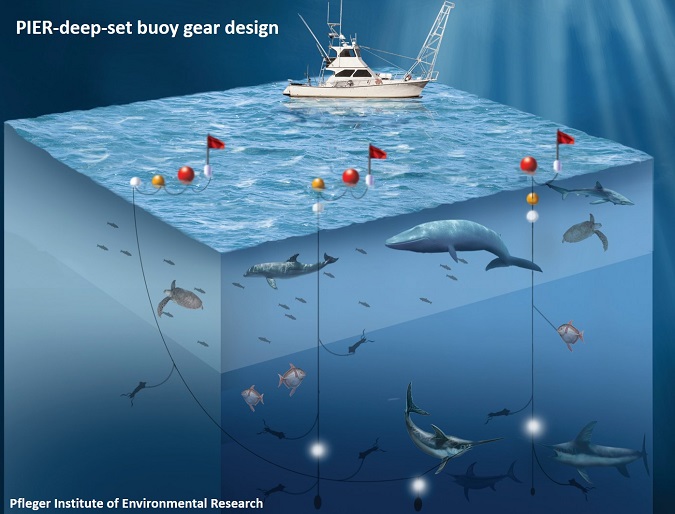A new method of fishing for Pacific swordfish off the West Coast is proving its value to both fishermen and protected species. As part of its effort to maximize economic benefits while minimizing non-target catch, the Pacific Fishery Management Council (PFMC) has considered and recommended to NOAA Fisheries a variety of exempted fishing permit (EFP) applications that, if issued, will test different methods to sustainably harvest Pacific swordfish.

The Pfleger Institute of Environmental Research (PIER), a non-profit organization that promotes sustainable fishing, is testing deep-set buoy gear under an EFP from NOAA Fisheries. East Coast fishermen have long used buoy-based fishing gear to target swordfish in shallow waters at night. The West Coast design uses heavy weights to lower baited hooks to depths of more than 1,000 feet during the day, avoiding unmarketable or federally protected species that reside in shallower waters.
The method is showing promise as another way to operate sustainable fisheries that minimize bycatch and interactions with protected species, such as marine mammals and sea turtles.
Deep-set bouy gear is designed to avoid unwanted species that reside in shallower waters. Design of this fishing technique was developed by PIER and funded by NOAA, Pew Charitable Trust, The Nature Conservancy, Santa Monica Seafood and George T. Pfleger Foundation. PIER graphic.
“We are happy with the progress that the EFP team has made thus far and pleased to see that the markets keep receiving the product at a premium,” said Chugey Sepulveda, research scientist at PIER. “We are hopeful that the use of deep-set buoy gear and possibly other methods that reduce the catch of unwanted species will provide new opportunities to West Coast fishermen in the years to come.”
NOAA Fisheries may issue an EFP to fishermen or organizations, such as PIER, to test new fisheries and gear or methods. The results, with public input, help the PFMC decide if the new approach can be scaled up to become a viable commercial fishery for recommendation to NOAA Fisheries.
“EFPs allow us to work with the fishing industry to develop new technologies that improve the sustainability of a particular fishery. They help us meet NOAA Fisheries’ mission of reducing the catch of unwanted species (also known as bycatch) and supporting the recovery of our protected resources,” said Christopher Fanning, a Fisheries Policy Analyst for NOAA Fisheries’ West Coast Region.
Deep-set buoy fishing takes advantage of the fact that different marine species feed at different depths at certain times of the day. Sea turtles, whales, and many fish are most commonly found in warm surface waters known as the upper mixed layer. Other fish, such as swordfish, opah, and bigeye thresher sharks, pursue food resources in deeper waters.
The deep-set buoy system uses heavy weights to rapidly lower baited hooks to target swordfish between 1,000 and 1,500 feet. The buoy gear’s strike detection system alerts fishermen when a fish is on the line and allows for its quick retrieval once hooked. It also preserves the quality and freshness of the catch and allows for the live release of any unwanted catch.
PIER designed a traceability tag that allows consumers to trace the swordfish they purchase to a deep-set buoy gear vessel. Photo by Ralph Pace, PIER
The rapid processing of the catch and high quality of the landed product brings a premium price at market. This helps compensate fishermen for the additional time and effort involved in buoy fishing.
To assure that buyers are getting what they pay for, PIER has designed a unique tagging program that links the deep-set buoy-caught fish with the plate of the consumer. A tag on every fish allows consumers to track the fish from vessel to plate. Consumers can use a project webpage on PIER’s website to verify that their product came from one of the deep-set buoy vessels.
Although the EFP trials have been promising, deep-set buoy fishing for Pacific swordfish still needs to be proven efficient and profitable enough to interest fishermen accustomed to other methods.
“NOAA Fisheries is committed to supporting the testing of sustainable fishing methods and we are encouraged by early results of EFPs issued to date to efficiently catch swordfish while also avoiding non-target species,” said Fanning.
PIER plans to apply for an EFP to test a larger-scale design that involves linking individual buoy systems together. The expanded design may be more attractive to larger commercial fishing operations looking for alternative methods for catching swordfish.
LEARN MORE about the status of EFPs for highly migratory fish species.
Home page photo: A traceability tag allows consumers to trace the swordfish they purchase to a deep-set buoy gear vessel. Photo by Ralph Pace, PIER
